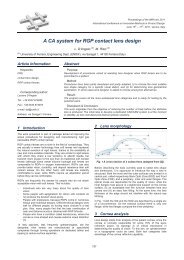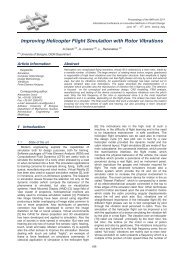Methods and tools dedicated to shoes customization ... - IMProVe2011
Methods and tools dedicated to shoes customization ... - IMProVe2011
Methods and tools dedicated to shoes customization ... - IMProVe2011
Create successful ePaper yourself
Turn your PDF publications into a flip-book with our unique Google optimized e-Paper software.
M. Germani et al. <strong>Methods</strong> <strong>and</strong> <strong><strong>to</strong>ols</strong> for <strong>shoes</strong> cus<strong>to</strong>misationprovide additional clinical variables as global footdeformity <strong>and</strong> pressures concentration level.Besides, foot motion data are used for driving 3Ddynamic foot geometry simulation. It employs data pointsfrom the foot surface measured during the gait cycle <strong>to</strong>drive corresponding data points in 3D geometric footsurface model derived from laser scanning system. Thesimulation is used <strong>to</strong> identify ideal flexion line in the shoe,foot girths values <strong>and</strong> fluctuation during motion <strong>and</strong> alsoinsole profile curves.On the other h<strong>and</strong>, non geometrical parameters, alsoreferred as clinical variables, have been identified in order<strong>to</strong> be: user activity level, types of activities undertaken,vascular status, neuropathy status, plantar soft tissueproperties, sweat production, site <strong>and</strong> nature of skinlesions, range of joint motion, muscle shortening. Theseparameters are assessed by the orthopedic specialist <strong>and</strong>each one ranked on a scale from 1 <strong>to</strong> 10.BiomechanicalvariablesActivity levelTypes of activitiesundertakenVascular statusNeuropathy statusPlantar soft tissuepropertiesSweat productionSite <strong>and</strong> nature of skinlesionsRange of joint motionMuscle shorteningAssessmentOrthopedicspecialistOrthopedicspecialistOrthopedicspecialistOrthopedicspecialistOrthopedicspecialistOrthopedicspecialistOrthopedicspecialistOrthopedicspecialistOrthopedicspecialistType of dataRank 1 <strong>to</strong> 10Rank 1 <strong>to</strong> 10Rank 1 <strong>to</strong> 10Rank 1 <strong>to</strong> 10Rank 1 <strong>to</strong> 10Rank 1 <strong>to</strong> 10Rank 1 <strong>to</strong> 10Rank 1 <strong>to</strong> 10Rank 1 <strong>to</strong> 10Foot geometry Foot digitizer 3D mesh modelFoot deformity Foot digitizer Rank 1 <strong>to</strong> 10Pressures map Foot digitizer Pressures mapPressures concentration Foot digitizer Rank 1 <strong>to</strong> 10Ideal flexion lineFoot girths values <strong>and</strong>fluctuationInsole profile curvesDynamicsmoduleDynamicsmoduleDynamicsmoduleNumeric valueNumeric intervalsProfile curvespractice have shown <strong>to</strong> be optimal for certain patientcategories.4.1 CAD systemThe input for designing insole <strong>and</strong> last is given by theresults of a <strong>dedicated</strong> measurement system constituted bya 3D laser scanner, baropodometric platform <strong>and</strong> a gait<strong>to</strong>ol for static <strong>and</strong> dynamic analysis. Outputs of thissystems are a sequence of foot pressure maps (.bmp or.csv files) <strong>and</strong> foot geometries (.stl mesh). The pressuremaps sequence is acquired during foot scanning, sopressure distribution over time can be analyzed. In fact,during scanning time span, patient could slightly move hisbody <strong>and</strong> pressure distribution changes.Foot Pressure Viewer reads a sequence of pressuremaps <strong>and</strong> extracts that one which better represents footplantar pressure, following a specific algorithm thatmaximizes the quantity of information that is available onthe map.Pressure map is acquired in a discrete way <strong>and</strong>represented by a cloud of points. Only points whosepressure value is not zero are included. Map point X <strong>and</strong>Y coordinate correspond <strong>to</strong> pressure sensor cell midpointwhile Z represents pressure value.An algorithm works on the point cloud in order <strong>to</strong>extract characteristic points, such as 1st <strong>and</strong> 5thmetatarsal points, most prominent points on heel area,medial metatarsal point, centre of pressure (COP) <strong>and</strong>pressure map barycentre (figure 3). Foot axis is alsocalculated, as the line that minimizes deviation amongpressure points (points are projected on XY plane). 1st<strong>and</strong> 5th metatarsal points are calculated as the mostexternal points of pressure map. Medial metatarsal pointis the midpoint for the two previous ones. Most prominentpoints are computed in a local reference system that isaligned with the foot axis. Between two possible points, ischosen that one which is more distant from medialmetatarsal point. COP is defined as midpoint betweenmost prominent <strong>and</strong> medial metatarsal ones. Barycentreis calculated as a weighted average point, where pressurevalue is used as weight.Tab. 1 Clinical <strong>and</strong> biomechanical variables.The whole clinic <strong>and</strong> biomechanical variables systemis elaborated by the knowledge based software in order <strong>to</strong>elaborate appropriate footwear components designparameters (FCDP). In particular outputs refers <strong>to</strong> lastselection, last typical measurements <strong>and</strong> girths, uppermaterials selection, shoe components options, heel height<strong>and</strong> shape prescriptions.The software that matches biomechanical parameterswith design parameters is based on a knowledge basereposi<strong>to</strong>ry represented by evidences from the literature<strong>and</strong> a wide selection of real test cases. The first type ofknowledge is implemented in algorithms which basicallyfilter the possible range of design parameters on the baseof the specific patient data when explicit rules can beformulated. On the other h<strong>and</strong> real test cases are s<strong>to</strong>redas a set of design solutions which experience <strong>and</strong>Fig. 3: Extraction of characteristic points of a pressure mapFoot Pressure Viewer has also a functionality <strong>to</strong>au<strong>to</strong>matically align foot mesh with pressure map, sincethese data are generally expressed in different referencesystems. The transformation matrix necessary <strong>to</strong> overlappressure <strong>to</strong> geometry is calculated from an alignmentprocess of the convex-hull curve of foot sole mesh <strong>and</strong>convex-hull curve of pressure map. This approach hasshown good reliability <strong>and</strong> efficiency. First curve isgenerated as follow: from foot mesh, a new one isgenerated from facets with vertices Z-coordinate less thana threshold value (foot scan is generally aligned along Xaxis <strong>and</strong> its sole on XY-plane). XY plane projectedJune 15th – 17th, 2011, Venice, Italy701Proceedings of the IMProVe 2011










